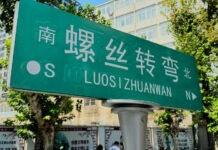The giant panda, often referred to affectionately as the “Giant Cat Bear,” possesses a name that naturally piques curiosity. While in English, “giant panda bear” is commonly used, its Chinese designation, “daxiongmao” (大熊猫), directly translates to “big bear cat.” This intriguing discrepancy leads many to question: should it more accurately be termed a “Big Cat Bear”? Indeed, observing a panda, one might easily see a creature that is both cat-like and bear-like in appearance.
Historically, this duality was even more pronounced in the panda’s Chinese nomenclature. During the 1930s, an animal exhibition at the Sichuan Museum showcased pandas, which quickly became the star attraction. The museum’s official signage identified these captivating animals as “maoxiong” (猫熊), meaning “bear with cat-like appearance.” Interestingly, this name was written in the traditional Chinese manner, from right to left.
 A street sign in Nanjing, China, with both English and Chinese characters
A street sign in Nanjing, China, with both English and Chinese characters
However, a shift in reading habits inadvertently altered the panda’s common name. By the 1920s, Chinese publications transitioned to Vernacular Chinese, read from left to right. Journalists visiting the museum, accustomed to this modern reading direction, mistakenly read “maoxiong” from left to right, resulting in “xiongmao” (熊猫). This new interpretation, “cat bear,” was then popularized through media reports. Despite the initial error being acknowledged later, “xiongmao” stuck and became the widely accepted name.
The English name “panda” also has an interesting etymological journey. It was borrowed from French, and its origins can be traced back to the Nepali word “ponya,” used to describe the red panda. Prior to 1901, when “panda” became the standard English term, the animal was simply known as the “Black and White Cat Footed-Animal,” highlighting the perceived feline characteristics even in English descriptions.
Throughout Chinese history, the panda has been known by over 20 different names, reflecting its unique features and the evolving understanding of the animal. These names include descriptive terms like “spotted bear” (huaxiong 花熊) and “bamboo bear” (zhuxiong 竹熊). In Taiwan, the name “damaoxiong” (大猫熊), or “big cat bear,” gained traction in 1988 and remains in use. Linguists argue that “damaoxiong” is not only more grammatically sound but also more logically descriptive of the animal’s mixed characteristics.
Today, the giant cat bear, or giant panda, faces significant conservation challenges. Classified as an endangered species since the 1980s, it is estimated that only around 2,000 remain in the wild. These iconic creatures are primarily found in the Western Sichuan province and surrounding forests. For those in Nanjing wanting to see a giant panda, the Hongshan Zoo offers a chance to observe these fascinating “giant cat bears” firsthand.
